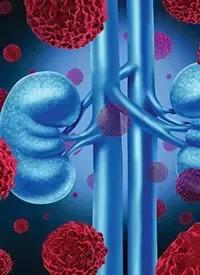Nab-Paclitaxel Plus Pembrolizumab Produces Promising Responses in Advanced Urothelial Cancer
Nab-paclitaxel plus pembrolizumab produced an encouraging overall response rate with manageable safety in patients with advanced urothelial cancer who were refractory to platinum-based chemotherapy or cisplatin ineligible, according to data from the phase 2 ABLE trial.

The combination of nab-paclitaxel (Abraxane) and pembrolizumab (Keytruda) produced an encouraging overall response rate (ORR) with manageable safety in patients with advanced urothelial cancer who were refractory to platinum-based chemotherapy or cisplatin ineligible, according to data from the phase 2 ABLE trial (NCT03240016) presented during the 2022 Genitourinary Cancers Symposium.1
At a median follow-up of 85.7 weeks (range, 26.3-194.0), nab-paclitaxel plus pembrolizumab (n = 36) elicited an unconfirmed best ORR of 55.6% (95% CI, 42%-74%) per RECIST v1.1 criteria in a total of 36 patients; this included 6 complete responses (CRs) and 14 partial responses. Moreover, 11 patients achieved stable disease, and 4 experienced disease progression. The combination was also found to result in a confirmed best ORR of 52.8%.
Anti–PD-1/PD-L1 therapy has proven to have efficacy in patients with advanced urothelial cancer who are either refractory to platinum-based chemotherapy or ineligible to receive cisplatin. When previously examined in these populations, pembrolizumab has been found to result in a median progression-free survival (PFS) of 2 months and a median overall survival (OS) ranging from 10 to 11 months, according to data from the phase 3 KEYNOTE-361 (NCT02335424) and KEYNOTE-045 (NCT02256436) trials.2,3 Additionally, nab-paclitaxel has also demonstrated activity in patients with platinum-refractory advanced disease. Despite these advances, there is a need to further improve outcomes for these patients.
The single-arm, 2-stage ABLE trial enrolled patients with recurrent, unresectable locally advanced or metastatic urothelial cancer who were platinum-refractory or cisplatin-ineligible per Galsky criteria. Patients had to be at least 18 years of age, have measurable disease per RECIST v1.1 criteria, an ECOG performance status ranging from 0 to 2, and acceptable organ function. They could not have peripheral neuropathy that was higher than grade 1 in severity.
Notably, 17 patients were enrolled to participate in the first stage of the trial, and 19 additional patients were enrolled to second stage, after at least 5 responses were observed in stage 1.
Study participants were administered 200 mg of intravenous (IV) pembrolizumab on day 1, plus 125 mg/m2 of IV nab-paclitaxel on days 1 and 8 of 21-day cycles. Notably, nab-paclitaxel could be discontinued after 6 cycles per patient or investigator preference. In the second stage of the trial, the starting dose of nab-paclitaxel was dropped to 100 mg/m2 due to grade 3 or higher adverse effects (AEs), which included fatigue, peripheral neuropathy, anemia, and oral mucositis.
The primary end point of the trial was ORR by RECIST v1.1 criteria. Secondary end points included PFS, OS, CR proportion, duration of response (DOR), duration of therapy, and safety.
The median age of patients enrolled to the trial was 71.5 years (interquartile range, 65.5-77.5), and 88.9% were male. The patient population was evenly divided among those with platinum-refractory and cisplatin-ineligible disease. Of the patients who were cisplatin ineligible, 44.4% had a creatinine clearance of less than 60, 16.7% had hearing loss, 16.7% had an ECOG performance status of 2, and 22.2% had more than 1 reason for ineligibility.
The primary tumor location was the bladder in 69.4% of patients and the upper tract in 30.6% of patients. Moreover, 86.1% of patients had metastatic disease, 41.7% had visceral disease, and 52.8% underwent prior surgery. Twenty-five percent of patients had an ECOG performance status of 0, 55.6% had a status of 1, and 19.4% had a status of 2. The starting dose of nab-paclitaxel was 125 mg/m2 for 47.2% of patients, and 52.8% started that agent at 100 mg/m2. Additionally, 41.7% of patients had a Bajorin score of 0, 55.6% had a score of 1, and 2.8% had a score of 2.
Additional data showed that the combination resulted in a median PFS of 6.8 months (95% CI, 4.4–not reached [NR]), and a median OS of 18.2 months (95% CI, 10.6-NR). The median DOR with the regimen was 19.1 weeks (95% CI, 16.7- 36.3). The median duration of therapy was 16.0 weeks (range, 1-NR) for nab-paclitaxel and 21.0 weeks (range, 0-NR) for pembrolizumab.
Any grade AEs that were frequently experienced with the combination included fatigue (n = 21), anemia (n = 14), alopecia (n = 12), peripheral sensory neuropathy (n = 12), dysgeusia (n = 10), diarrhea (n = 9), pruritus (n = 8), and rash maculopapular (n = 7). The most common grade 3 to 5 toxicities were fatigue (n = 6), anemia (n = 4), peripheral sensory neuropathy (n = 3), oral mucositis (n = 3), and decreased neutrophil count (n = 2).
Notably, 7 patients discontinued treatment due to AEs. Ten patients experienced grade 3 or higher immune-mediated AEs due to pembrolizumab.
Serious toxicities experienced with the regimen included thromboembolic events (n = 3) and urinary tract infection (n = 2), as well as acute kidney injury, blurred vision, delirium, disease progression, disease progression with metastases to the brain, encephalitis, encephalopathy, fever, hiccoughs, hip fracture, hypercalcemia, pneumonia, pyelonephritis, sepsis, sinus bradycardia, and transient ischemic attack/brain ischemia (n = 1, each).
References
- Tsung I, Green E, Palmbos P, et al. A phase 2 trial of nab-paclitaxel in combination with anti-PD1 in advanced urothelial cancer. J Clin Oncol. 2022;40(suppl 6):502. doi:10.1200/JCO.2022.40.6_suppl.502
- Arjun V Balar AV, Castellano D, O'Donnell PH, et al. First-line pembrolizumab in cisplatin-ineligible patients with locally advanced and unresectable or metastatic urothelial cancer (KEYNOTE-052): a multicentre, single-arm, phase 2 study. Lancet Oncol. 2017;18(11):1483-1492. doi:10.1016/S1470-2045(17)30616-2
- Bellmunt J, de Wit R, Vaughn DJ, et al. Pembrolizumab as second-line therapy for advanced urothelial carcinoma. N Engl J Med. 2017;376(11):1015-1026. doi:10.1056/NEJMoa1613683



